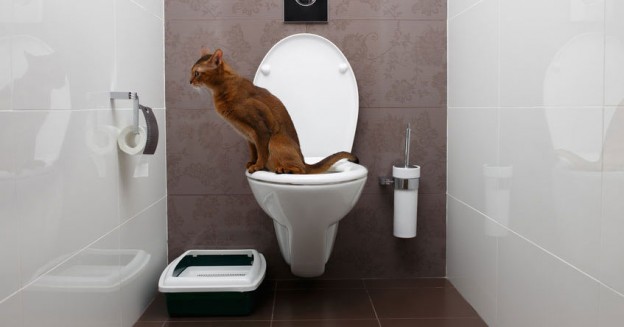The Dangers of Flushing Cat Poop Down Your Toilet - Advice for Better Disposal
The Dangers of Flushing Cat Poop Down Your Toilet - Advice for Better Disposal
Blog Article
The article author is making several great pointers on Can You Flush Cat Poo or Litter Down the Toilet? overall in this post on the next paragraphs.

Intro
As cat proprietors, it's necessary to be mindful of how we get rid of our feline pals' waste. While it may seem hassle-free to purge cat poop down the toilet, this practice can have harmful repercussions for both the atmosphere and human health and wellness.
Alternatives to Flushing
Thankfully, there are safer and more responsible means to take care of feline poop. Consider the complying with alternatives:
1. Scoop and Dispose in Trash
The most typical technique of throwing away cat poop is to scoop it right into an eco-friendly bag and throw it in the garbage. Make sure to use a committed litter scoop and deal with the waste without delay.
2. Use Biodegradable Litter
Select biodegradable cat trash made from products such as corn or wheat. These litters are environmentally friendly and can be securely dealt with in the garbage.
3. Bury in the Yard
If you have a yard, consider burying feline waste in a marked location far from vegetable gardens and water sources. Make sure to dig deep enough to prevent contamination of groundwater.
4. Set Up a Pet Waste Disposal System
Buy a pet waste disposal system specifically designed for feline waste. These systems utilize enzymes to break down the waste, lowering odor and ecological effect.
Wellness Risks
Along with environmental problems, purging feline waste can also present health and wellness dangers to human beings. Feline feces may contain Toxoplasma gondii, a bloodsucker that can create toxoplasmosis-- a potentially severe ailment, specifically for expectant ladies and people with damaged immune systems.
Ecological Impact
Flushing feline poop introduces unsafe microorganisms and bloodsuckers into the water, positioning a substantial risk to water ecological communities. These contaminants can adversely affect aquatic life and concession water top quality.
Final thought
Liable pet ownership prolongs beyond supplying food and sanctuary-- it additionally entails correct waste monitoring. By avoiding purging pet cat poop down the commode and going with different disposal approaches, we can decrease our ecological footprint and safeguard human health.
Why Can’t I Flush Cat Poop?
It Spreads a Parasite
Cats are frequently infected with a parasite called toxoplasma gondii. The parasite causes an infection called toxoplasmosis. It is usually harmless to cats. The parasite only uses cat poop as a host for its eggs. Otherwise, the cat’s immune system usually keeps the infection at low enough levels to maintain its own health. But it does not stop the develop of eggs. These eggs are tiny and surprisingly tough. They may survive for a year before they begin to grow. But that’s the problem.
Our wastewater system is not designed to deal with toxoplasmosis eggs. Instead, most eggs will flush from your toilet into sewers and wastewater management plants. After the sewage is treated for many other harmful things in it, it is typically released into local rivers, lakes, or oceans. Here, the toxoplasmosis eggs can find new hosts, including starfish, crabs, otters, and many other wildlife. For many, this is a significant risk to their health. Toxoplasmosis can also end up infecting water sources that are important for agriculture, which means our deer, pigs, and sheep can get infected too.
Is There Risk to Humans?
There can be a risk to human life from flushing cat poop down the toilet. If you do so, the parasites from your cat’s poop can end up in shellfish, game animals, or livestock. If this meat is then served raw or undercooked, the people who eat it can get sick.
In fact, according to the CDC, 40 million people in the United States are infected with toxoplasma gondii. They get it from exposure to infected seafood, or from some kind of cat poop contamination, like drinking from a stream that is contaminated or touching anything that has come into contact with cat poop. That includes just cleaning a cat litter box.
Most people who get infected with these parasites will not develop any symptoms. However, for pregnant women or for those with compromised immune systems, the parasite can cause severe health problems.
How to Handle Cat Poop
The best way to handle cat poop is actually to clean the box more often. The eggs that the parasite sheds will not become active until one to five days after the cat poops. That means that if you clean daily, you’re much less likely to come into direct contact with infectious eggs.
That said, always dispose of cat poop in the garbage and not down the toilet. Wash your hands before and after you clean the litter box, and bring the bag of poop right outside to your garbage bins.
https://trenchlesssolutionsusa.com/why-cant-i-flush-cat-poop/

I am very fascinated with How to Dispose of Cat Poop and Litter Without Plastic Bags and I'm hoping you enjoyed my entry. If you enjoyed reading our blog entry plz do not forget to pass it around. Thanks for your time. Don't forget to stop by our site back soon.
Contact Report this page